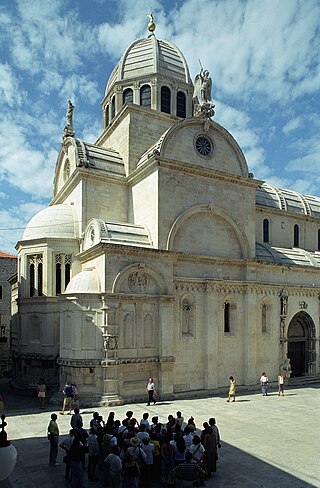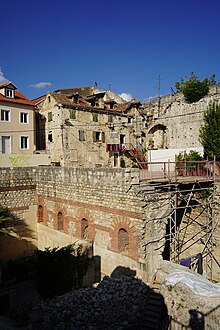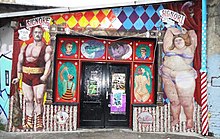
Croatia, officially the Republic of Croatia, is a country located at the crossroads of Central and Southeast Europe. Its coast lies entirely on the Adriatic Sea. It borders Slovenia to the northwest, Hungary to the northeast, Serbia to the east, Bosnia and Herzegovina and Montenegro to the southeast, and shares a maritime border with Italy to the west. Its capital and largest city, Zagreb, forms one of the country's primary subdivisions, with twenty counties. Other major urban centers include Split, Rijeka and Osijek. The country spans 56,594 square kilometres, and has a population of nearly 3.9 million.

Zadar, historically known as Zara, is the oldest continuously inhabited city in Croatia. It is situated on the Adriatic Sea, at the northwestern part of Ravni Kotari region. Zadar serves as the seat of Zadar County and of the wider northern Dalmatian region. The city proper covers 25 km2 (9.7 sq mi) with a population of 75,082 in 2011, making it the second-largest city of the region of Dalmatia and the fifth-largest city in the country.

Split-Dalmatia County is a central-southern Dalmatian county in Croatia. The administrative center is Split. The population of the county is 455,242 (2011). The land area is 14.106,40 km2. Split-Dalmatia County is Croatia's most rapidly urbanising and developing region, as economic opportunities and living standards are among the highest alongside capital Zagreb and Istria County.

Culture of Croatia has historically been influenced by Central European, Mediterranean and Balkan cultures. Croatia's unique culture and identity can be traced back to the historical llyricum. The Croatian language is believed to have been formed in the 6th or 7th century, and the written language is present in Glagolitic texts from the 11th century.

Hrvatska radiotelevizija, or Croatian Radiotelevision, is Croatia's public broadcasting company. It operates several radio and television channels, over a domestic transmitter network as well as satellite. HRT is divided into three joint companies – Croatian Radio, Croatian Television and Music Production, which includes three orchestras and a choir.

Tourism in Croatia is a major industry of country's economy, accounting for almost 20% of Croatia's gross domestic product (GDP) as of 2021.

Nogometni klub Istra 1961, commonly referred to as NK Istra 1961, or simply Istra 1961 or Istra, is a Croatian professional football club based in Pula, that competes in the Croatian First League.

Thompson is a Croatian ethno hard rock band, founded by songwriter and lead vocalist Marko Perković ("Thompson"), who is often identified with the band itself. The lineup consists of Tomislav Mandarić, Ivan Ivanković, Duje Ivić, and Ivica Bilić Ike.
Natali Dizdar, also known as Natalie Dizdar, is a Croatian pop singer.

Zadar Airport is an international airport serving Zadar, Croatia. It is located in Zemunik Donji, 8 km (5 mi) from the centre of Zadar. It is rapidly growing now with 70 destinations and had its 1,000,000th passenger in September 2023. It is the fourth busiest airport in Croatia.

Zagreb Pride is the annual LGBTIQ+ pride march in the city of Zagreb, Croatia, which first took place in 2002, as the first successful pride march in Southeast Europe. Zagreb Pride organizers say their work was inspired by the Stonewall Riots and the Gay Liberation Front. It is self-identified as LGBTIQ+ march and therefore in 2003 changed its name from Gay Pride Zagreb into Zagreb Pride. The Pride was organized by a volunteer-based and grass-roots Organizing Committee that was formed each year. A new organization founded in 2008 as a non-governmental organization Zagreb Pride that also registered the use of the name as a brand. The organization is a member of InterPride, EPOA, IGLYO, ILGA-Europe and in 2010, together with Lesbian Organization LORI and Domino, it was the founding member of Croatian first national LGBT association, Center for LGBT Equality. Pride receives funding from the City of Zagreb and a number of international human rights organizations and embassies.

The architecture of Croatia has roots in a long history: the Croats have inhabited the area for fourteen centuries, but there are important remnants of earlier periods still preserved in the country.
The 2008–09 Croatian First Football League was the eighteenth season of the Croatian First Football League, the national championship for men's association football teams in Croatia, since its establishment in 1992. It started on 27 July 2008 and ended on 31 May 2009. Dinamo Zagreb were the defending champions, having won their twelfth championship title the previous season, and they defended the title again, after a win against Slaven Belupo on 17 May 2009.
The 2010–11 Croatian First Football League was the 20th season of the Croatian First Football League, the national championship for men's association football teams in Croatia, since its establishment in 1992. It began on 23 July 2010 and ended on 21 May 2011. Dinamo Zagreb were the defending champions, having won their 12th championship title the previous season, and they defended the title again.
Dalibor Zebić is a Croatian professional football manager and former player.

Massimo Moreno Savić, also known simply as Massimo, was a Croatian pop singer.
The 2014–15 Croatian First Football League was the 24th season of the Croatian First Football League, the national championship for men's association football teams in Croatia, since its establishment in 1992. The season started on 18 July 2014 and ended on 30 May 2015.
The 2015–16 Croatian First Football League was the 25th season of the Croatian First Football League, the national championship for men's association football teams in Croatia, since its establishment in 1992. The season began on 10 July 2015 and ended on 14 May 2016.

Diplomatic relations between the republics of Croatia and Ireland were established on 27 January 1995 following Croatia's independence from SFR Yugoslavia. Ireland recognised Croatia as an independent state on 15 January 1992. Croatia is represented in Ireland through consulate and embassy in Dublin, while Ireland is represented in Croatia through its embassy and consulate in Zagreb. Both countries are full members of Council of Europe and of the European Union. In 2019, Croatian community in Ireland counted around 20,000 people.

Theatre in Croatia refers to the history of the performing arts in Croatia, or theatrical performances written, acted and produced by Croatians. Croatian theatre generally falls into the Western theatre tradition, with influences especially from Italy, Germany, Austria and other European nations.

















